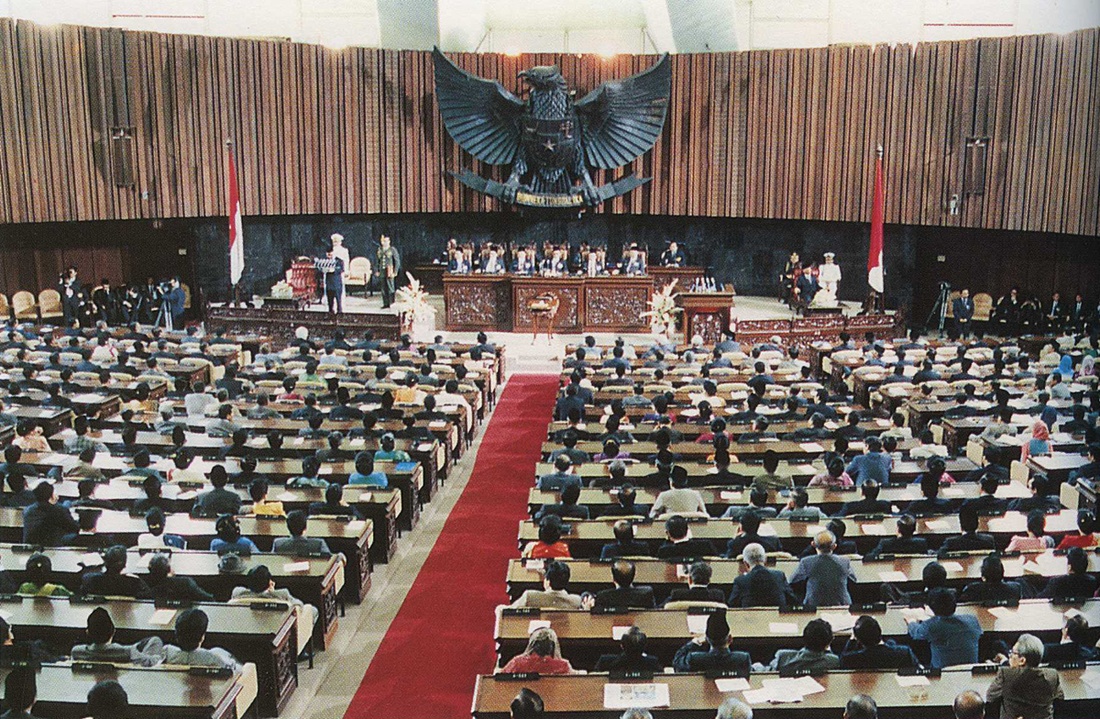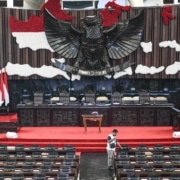
The reinstatement of the State Policy Guidelines, or GBHN, could see the People’s Consultative Assembly (MPR) return to being the highest authority in the country, as it was under the New Order.
Although discussions have barely made a blip in the national media, for more than a year, the People’s Consultative Assembly (MPR) has been quietly working on attempts to amend Indonesia’s 1945 Constitution for a fifth time.
The idea has been pursued in a range of seminars, public forums, and discussions in universities across the country. An expert team has been formed to examine proposed amendments, and has already produced a number of studies.
MPR Chairman Zulkifli Hasan has previously stated that discussions on constitutional amendment were still in their early stages, but there was broad agreement on the need to reinstate the concept of State Policy Guidelines (GBHN).
Although the term “state policy guidelines” might sound rather innocuous, reinstatement of the GBHN could have grave political consequences.
The initial GBHN concept was present in the original 1945 Constitution. Article 1(2) of the Constitution stated that “sovereignty is vested in the people and is exercised in full by the MPR”. The Constitution also described the MPR as being responsible for determining the guidelines for state policy, under Article 3.
The process for formulating the GBHN was not clearly described in the original 1945 Constitution. The GBHN was understood as a formal document of broad directive principles, representing the mandate given to the president by the MPR. It should be remembered that until the reform era, the MPR was the highest authority in the country, responsible for selecting (and dismissing) the president – a system not unlike a parliamentary system. The president was, in theory, selected by the MPR to implement the directives outlined in the GBHN.
But in reality, the president was rarely held accountable to the MPR in this manner. With the brief provisions in the 1945 Constitution as its basis, the Provisional People’s Consultative Assembly (MPRS) in Soekarno’s Guided Democracy adopted Soekarno’s political manifesto as the GBHN in 1960. Under Soeharto, many MPR members were appointed by or allied with the president, and the GBHN was simply imposed on the MPR by Soeharto as his development plan.
After the constitutional amendments of 1999-2002, Article 1(2) was altered to become: “sovereignty is vested in the people and is exercised according to the Constitution”. With this reform, the people’s sovereignty was no longer exercised by the MPR as the most powerful institution, but rather via the state agencies outlined in the Constitution. The 1999-2002 amendments also adopted a presidential system, which later involved direct presidential elections and a power of impeachment held by the Constitutional Court.
These changes marked the arrival of important checks and balances in the structure of the Indonesian state. Key state institutions, such as the president, the People’s Representative Council (DPR), the Supreme Court, Constitutional Court, and the Judicial Commission, were able to “compete” with one another, ensuring that no single institution became too dominant. With these changes, there was an opening of democratic space and vast improvements in transparency.
If the GBHN is reinstated, the MPR may well return to being the highest authority in the land. It is reasonable to ask whether the MPR has something else in mind by reinstalling the GBHN. There would not be much point in bringing back the GBHN unless the president was then held accountable to the MPR over his or her progress in implementing the guidelines. This could result in a much more dominant MPR and could conceivably lead to the MPR having the authority to remove (or appoint) presidents based on their ability to implement the guidelines. Is this what the MPR intends?
If the MPR insists on reinstating the GBHN, the country’s whole system of governance could be thrown into disorder. If the MPR really wants to return to the model of rule via the GBHN, it would need to make comprehensive changes to the structure of the Indonesian state and revert to a parliamentary system. This would be the only way to ensure consistency.
This is not to suggest that Indonesia needs to replicate in full the presidential model adopted in other countries, or models advocated by political scientists. In designing a system of government, however, the most important consideration should be which system is best able to achieve the needs of the country. The fact is, the checks and balances introduced since 1999-2002 have allowed the development of a political arena that is far more transparent and accountable than anything that came before it.
Of course, there are many problems with Indonesia’s system of government. Many of them can be improved by simply revising laws and policy. Others require fundamental change to the Constitution. But if constitutional change is to occur, in-depth studies must be conducted about the possible implications for the existing system.
The whole way that the MPR has gone about this process has been flawed. The MPR leadership has not made any attempt to start a national conversation on the issue. The series of activities that have already been held and are now claimed as public consultation were only held in selected universities – institutions home to public administration and governance academics critical of the GBHN proposal were not included. This equation of “public” with “political elites and academics” is a major concern.
This restriction of the understanding of the “public” is a problem in many democracies. But amendments to the Constitution are not simply an issue for political elites. The Constitution is the source of all law in Indonesia, and is binding on all citizens.
Since the 1999-2002 constitutional amendments, the MPR only exists when the DPR and Regional Representatives Council (DPD) are in session together. It is not an independent institution – despite the fact that this is how it is often understood. According to the Constitution, the MPR cannot make a decision as an institution except in a session including members of both houses, the DPR and DPD.
But this hasn’t seemed to bother the MPR leadership, which has already begun the first phase of the process for amending the 1945 Constitution. MPR head Zulkifli revealed as much in a speech to open the “National Convention on State Policy: Returning State Sovereignty Through State Policy” in March.
The elitist and hasty nature of the process needs to be seriously questioned. We are talking about a social contract that affects all citizens. Amending the Constitution should be a shared agenda of the nation, not a project led by the leaders of the MPR.
The door should always be open to constitutional amendment. But change must be based on sound argument and following a transparent, participative and deliberate process. Reinstating the GBHN has the potential to throw Indonesia’s political system into disarray. The DPR and DPD, as the constituent parts of the MPR, must respond critically to the MPR leadership’s proposal. It would be a disaster if the fifth constitutional amendment went ahead without broad public consultation or strong political justification.






